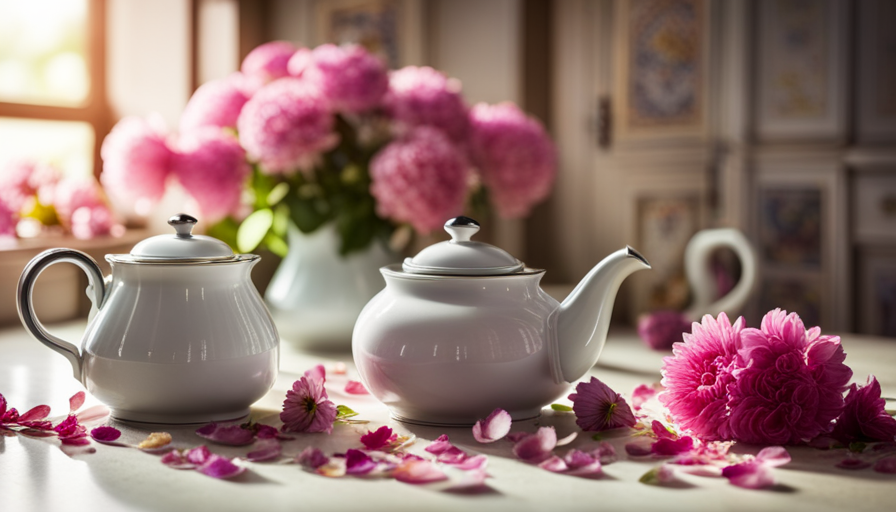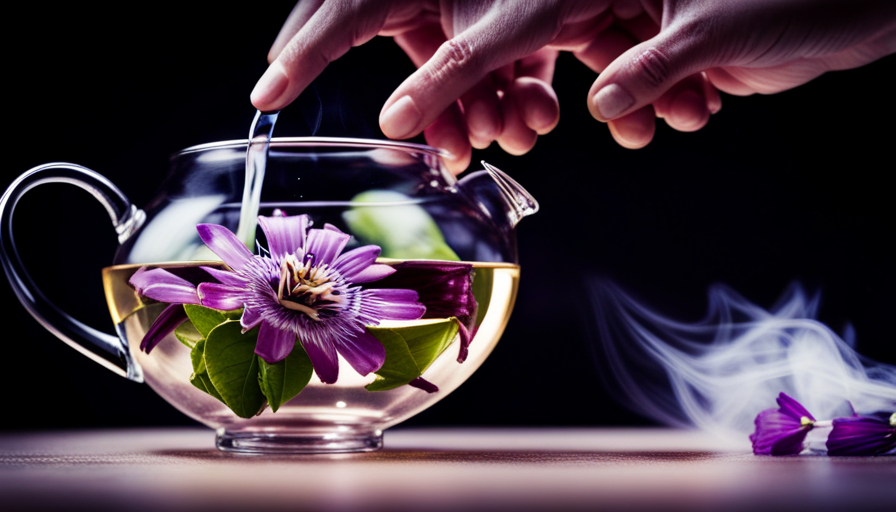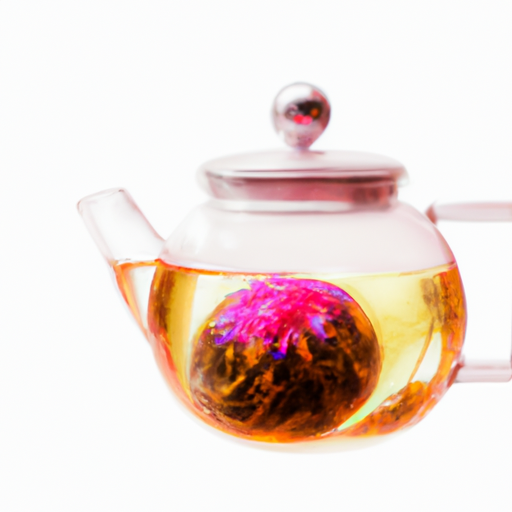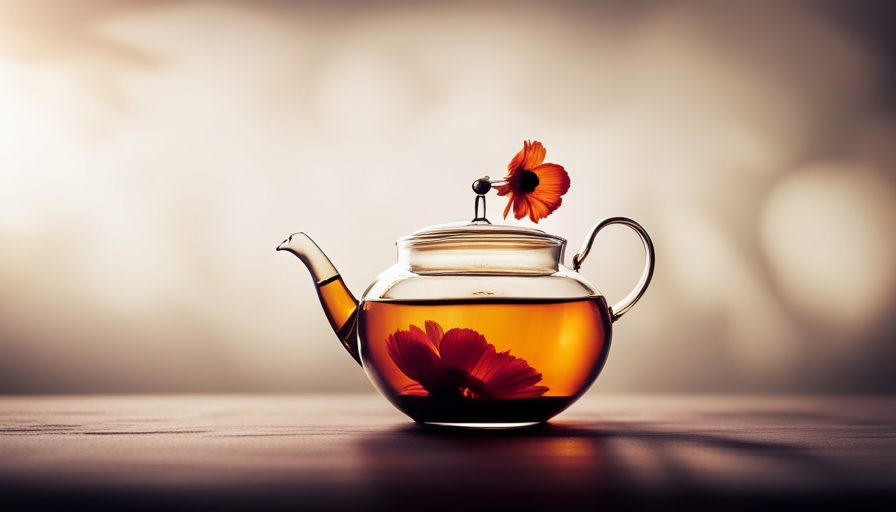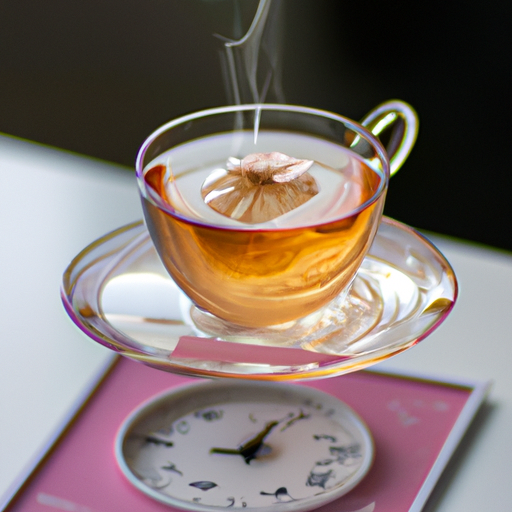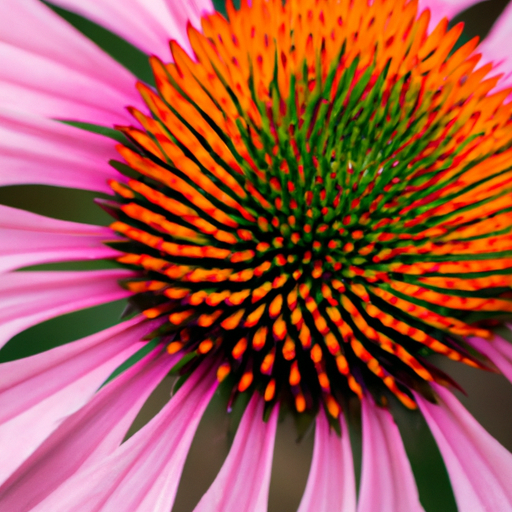Have you ever considered incorporating flower petals into your tea to not only enhance the visual appeal but also reap health benefits?
In fact, studies have shown that certain flower petals contain antioxidants and other compounds that can help boost immunity and promote overall well-being.
In this article, I will guide you through the process of making tea using flower petals, from choosing the right flowers to preparing the tea and even sharing some delicious floral tea recipes.
Whether you want to enhance your tea-drinking experience or simply explore new flavors, incorporating flower petals into your tea can be a delightful and refreshing change.
Join me as we delve into the world of floral teas and discover the art of infusing petals into our favorite beverage.
Key Takeaways
- Flower petals can be added to tea for both aesthetic and health benefits.
- Certain flower petals contain antioxidants and compounds that boost immunity and promote well-being.
- Floral teas are rich in antioxidants, combating free radicals and reducing inflammation.
- Proper brewing techniques for flower petal tea include cold brewing, steam infusion, and combination brewing.
Benefits of Using Flower Petals in Tea
To enhance your tea experience, you’ll be amazed at the myriad of health benefits flower petals bring to your brew. Flower petal tea recipes have been used for centuries to promote overall well-being and provide a natural boost to the immune system.
Incorporating these beautiful and fragrant petals into your tea not only adds a visually appealing touch but also imparts a delicate flavor that can transform your everyday cup of tea into a luxurious indulgence.
One of the key health benefits of floral teas is their rich antioxidant content. Flower petals are packed with antioxidants that help combat free radicals and reduce inflammation in the body. Regular consumption of floral teas can boost your immune system, protect against chronic diseases, and slow down the aging process.
In addition to their antioxidant properties, flower petal teas are known for their calming and soothing effects. Certain flowers, such as chamomile and lavender, have natural sedative properties that can promote relaxation and improve sleep quality. Other flowers, like hibiscus and rose, are known for their ability to lower blood pressure and improve cardiovascular health.
When choosing the right flowers for your tea, it’s important to select organic and pesticide-free varieties to ensure the highest quality and purity. Experiment with different combinations of flowers to create unique flavors and aromas that suit your taste preferences.
So, let’s dive into the world of floral teas and discover the perfect petals to elevate your tea experience.
Choosing the Right Flowers
When selecting the ideal flowers for making tea using flower petals, it’s crucial to consider their vibrant hues and delightful fragrances. Not all flowers are suitable for consumption, so it’s important to choose edible flower options.
Some popular choices include rose petals, lavender, chamomile, hibiscus, and jasmine. These flowers not only add a burst of color to your tea, but they also impart their unique flavors and aromas.
In addition to their visual and sensory appeal, floral teas offer various health benefits. Rose petals, for example, are known for their calming effects and can help alleviate stress and anxiety. Lavender, on the other hand, can aid in digestion and promote relaxation. Chamomile is well-known for its soothing properties and can help with sleep issues. Hibiscus flowers are rich in antioxidants and can help lower blood pressure. Jasmine, with its sweet fragrance, can uplift your mood and improve mental alertness.
When preparing the tea, it’s important to handle the flowers gently to preserve their delicate flavors and aromas. Steeping the petals in hot water for a few minutes allows the flavors to infuse into the tea. It’s fascinating to witness how these beautiful flowers transform into a delightful and fragrant beverage.
Preparing the Tea
When preparing tea using flower petals, there are a few key points to consider.
Firstly, you can choose to use either fresh or dried flowers, depending on your preference and availability.
Secondly, it’s important to follow proper brewing techniques to ensure a flavorful and aromatic cup of tea.
Lastly, you can enhance the flavor of your tea by adding other ingredients such as herbs or spices.
By considering these factors, you can create a delightful and personalized flower petal tea.
Fresh or Dried Flowers
Using fresh or dried flowers adds a delightful and aromatic touch to your tea-making experience! Whether you choose fresh or dried flowers depends on your personal preference and the availability of flowers. Fresh flowers have the advantage of providing a stronger and more vibrant flavor to your tea. They also retain their natural colors and aromas, creating a visually appealing and fragrant beverage. On the other hand, dried flowers have a longer shelf life and can be easily stored for future use. They are also convenient if you don’t have access to fresh flowers year-round. Both fresh and dried flowers offer unique benefits and can enhance the taste and aroma of your tea. Now that you know about the different options for flower petals, let’s dive into the proper brewing techniques for the perfect cup of tea.
Proper Brewing Techniques
To achieve a truly exquisite cup of tea, one must master the art of brewing, like a conductor orchestrating a symphony of flavors and aromas. When using flower petals to brew tea, there are alternative brewing methods that can enhance the experience.
-
Cold brewing: Steeping flower petals in cold water for several hours allows the delicate flavors to slowly infuse, resulting in a refreshing and subtly sweet tea.
-
Steam infusion: Placing flower petals in a heatproof dish and pouring hot water over them, then covering the dish to let the steam infuse the flavors, creates a more intense and fragrant tea.
-
Combination brewing: Mixing flower petals with traditional tea leaves can create a unique blend of flavors, offering a delightful twist to your usual cup of tea.
In addition to their exquisite taste, flower petal teas also offer various health benefits. They’re known for their antioxidant properties and can aid in digestion and relaxation. By incorporating other ingredients for flavor, such as herbs or fruits, you can create a tea that’s truly one-of-a-kind.
Adding Other Ingredients for Flavor
Enhance the sensory experience of your brew by incorporating a medley of aromatic herbs and vibrant fruits, transforming your cup of tea into a tapestry of flavors. When infusing herbal teas, experimenting with flavors can be a delightful journey of discovery. By adding various ingredients, you can create unique blends that cater to your taste preferences. Consider combining dried lavender with chamomile for a calming and floral tea, or infusing rose petals with hibiscus for a refreshing and tangy brew. To help you on your flavor exploration, here is a table showcasing some popular ingredients and the flavors they bring to your tea:
| Ingredient | Flavor |
|---|---|
| Lemon | Citrus |
| Mint | Refreshing |
| Ginger | Spicy |
| Raspberry | Sweet |
| Peach | Fruity |
By incorporating these flavors, you can create endless possibilities for your tea concoctions. Now, let’s move on to explore some delightful floral tea recipes.
Floral Tea Recipes
Floral tea recipes can add a unique and delicate flavor to your daily tea routine. They also provide various health benefits by incorporating flower petals into your tea. Here are some floral tea blends to try:
-
Rose and hibiscus: This blend offers a vibrant and refreshing taste. It also provides antioxidants that promote skin health and boost the immune system.
-
Jasmine and green tea: The floral aroma of jasmine combined with the grassy notes of green tea creates a soothing and aromatic blend. It aids in digestion and reduces inflammation.
-
Elderflower and peppermint: This combination delivers a minty and floral flavor. It is known for its calming effects on the digestive system and its ability to alleviate headaches.
-
Chamomile and lavender: This classic blend is renowned for its relaxing properties. It helps improve sleep quality and reduce anxiety.
These floral tea blends not only offer a delightful taste but can also provide numerous health benefits.
Now, let’s explore the art of tea etiquette and presentation, which adds a touch of elegance to your tea-drinking experience.
Tea Etiquette and Presentation
Immerse yourself in the elegance and refinement of tea etiquette and presentation as you discover the art of creating a visually stunning and perfectly balanced tea experience. In the world of tea, there’s a rich tradition of ceremonies and rituals that enhance the enjoyment of this beloved beverage.
The tea ceremony, often steeped in cultural significance, is a time-honored practice that showcases the beauty and grace of tea preparation. Tea rituals vary across different cultures, but they all share the common goal of creating a sense of harmony and tranquility. From the precise movements of the tea master to the careful selection of tea utensils, every aspect of the ceremony is thoughtfully considered. Each gesture and action has a purpose, whether it’s to purify the mind and body or to appreciate the beauty of the tea leaves.
Presentation is equally important in the tea ceremony. Delicate teacups, ornate teapots, and elegant serving trays are meticulously chosen to enhance the visual appeal of the tea experience. The art of pouring tea is practiced with grace and precision, ensuring that each guest receives a perfectly brewed cup.
As we delve into the next section about storing and preserving flower petals, it’s important to remember that the tea ceremony and its rituals aren’t just about the final product. They’re a celebration of the senses, a way to connect with others, and a reminder to slow down and savor the moment.
Storing and Preserving Flower Petals
Don’t you just love finding creative ways to store and preserve the delicate beauty of flower petals, like capturing their essence in a jar or creating vibrant potpourri to adorn your living space? Preserving flower petals is a wonderful way to extend their lifespan and enjoy their beauty for a longer period of time.
Here are four creative uses for flower petals that you can try at home:
-
Pressed flower art: Pressing flower petals between heavy books or using a flower press can create stunning and delicate works of art. Frame them or use them to decorate homemade cards and crafts.
-
Flower-infused oils: Infusing flower petals in oils, such as olive or jojoba oil, can create beautifully scented oils that can be used for massages, skincare, or even in cooking.
-
Flower petal bath bombs: Crushed flower petals can be added to homemade bath bombs for a luxurious and relaxing bath experience. They add a touch of beauty and fragrance to your self-care routine.
-
Floral sachets: Create sachets by filling small fabric bags with dried flower petals. These sachets can be placed in drawers, closets, or even under your pillow to infuse your surroundings with a delightful scent.
Preserving flower petals allows us to enjoy their beauty long after they’ve been picked. Get creative with these ideas and let the delicate beauty of flower petals enhance your daily life.
Frequently Asked Questions
Can I use any type of flower petals for making tea?
Yes, you can use various types of flower petals to make tea. Some popular options include chamomile, rose, lavender, and hibiscus petals. Each flower imparts its unique flavor and aroma to the tea.
To brew flower tea, start by boiling water and then adding the petals. Let it steep for a few minutes before straining and enjoying your floral-infused beverage. Experiment with different flower combinations to find your preferred taste.
How long do flower petals last when used in tea?
Flower petals, when used in tea, can last for a considerable amount of time if properly stored. Preserving their freshness is crucial to ensure their potency and flavor. To extend their shelf life, store the petals in an airtight container away from heat and sunlight.
However, it’s important to note that over time, the long-term effects of using flower petals in tea may diminish, resulting in a milder taste. So, it’s best to consume them within a reasonable timeframe for optimal enjoyment.
Can I drink flower tea if I have allergies to certain flowers?
Yes, it’s possible to drink flower tea even if you have allergies to certain flowers. However, it’s important to be cautious and consult with a healthcare professional before consuming any new herbal remedies, especially during pregnancy. Some flowers used in tea, like chamomile or lavender, are known for their calming properties and may help alleviate allergies naturally. It’s always best to err on the side of caution and seek personalized advice for your specific situation.
Are there any specific health benefits associated with drinking tea made from flower petals?
Drinking tea made from flower petals is like unlocking a secret garden of health benefits. These delicate blooms offer a plethora of unique advantages to our well-being.
Different types of flower tea provide distinct health benefits. For example, chamomile tea promotes relaxation and aids in digestion, while hibiscus tea is rich in antioxidants and helps lower blood pressure.
Additionally, sipping on floral infusions not only nourishes the body but also connects us to the rich history and cultural significance of this age-old tradition.
How can I incorporate flower tea into my daily routine for maximum benefits?
To incorporate flower tea into my daily routine for maximum benefits, I explore various ways to consume it. Flower tea can be enjoyed hot or cold, and it can be brewed using a teapot or steeped in a tea infuser.
Additionally, I can add flower tea to smoothies or use it as a base for herbal cocktails. Not only does flower tea offer potential health benefits, but it can also enhance skincare due to its natural antioxidants and soothing properties.
Conclusion
In conclusion, using flower petals in tea not only adds a delightful visual appeal but also brings numerous health benefits. By carefully selecting the right flowers and following the proper preparation techniques, one can create a soothing and aromatic cup of floral tea.
From calming lavender to invigorating rose petals, the options are endless. For example, a study conducted at a renowned botanical garden found that chamomile tea made with freshly picked chamomile flowers significantly reduced anxiety levels in participants.
So why not add a touch of nature to your tea experience and enjoy the wonderful flavors and benefits of floral tea?

